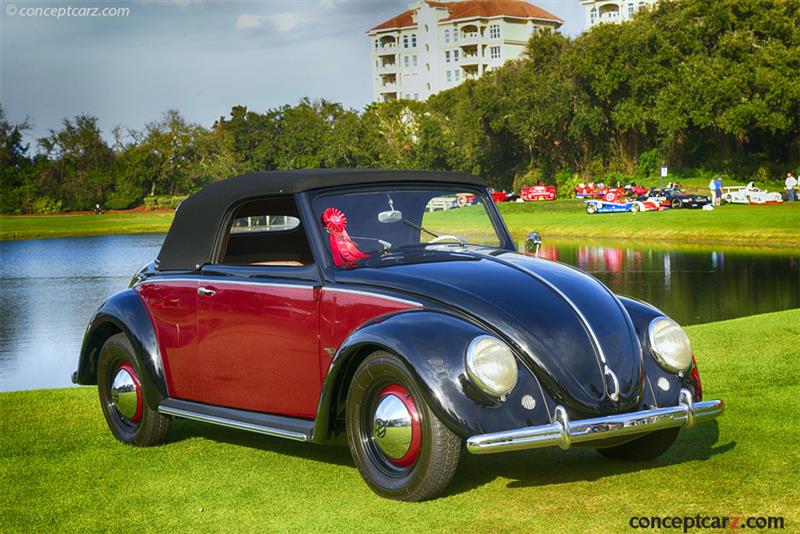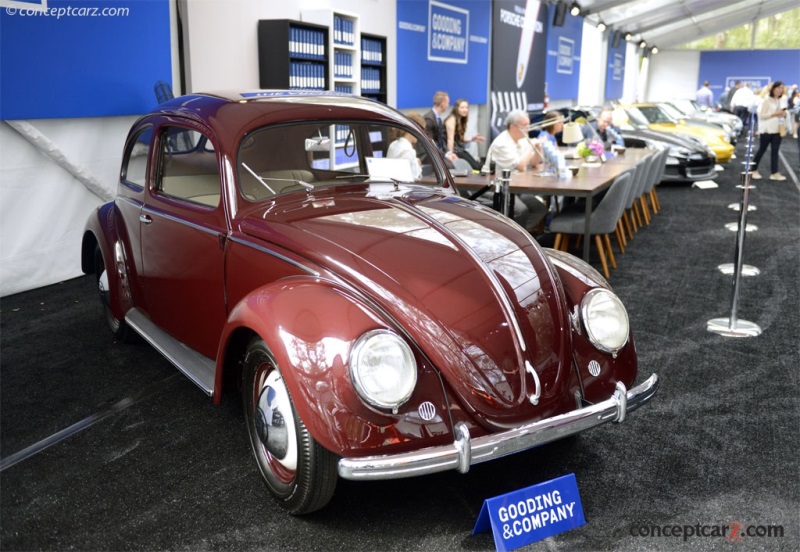History
The Beetle is perhaps the best-selling car of all time. Truly, a recognizable shape that has stood the test of time. The vehicle is still being produced in Mexico, continuing the long-time running record.
Adolf Hitler was searching for a people's car that was capable of transporting three children and two adults at speeds of sixty miles-per-hour. The car was to be inexpensive, costing the same as a motorcycle. Ferdinand Porsche was commissioned to produce such a vehicle.
There are many theories as to where the designs originated from. Some believe Hitler designed the vehicle. Some theorize that it was Joseph Ganz's 1920 design that was the true inspiration for the Beetle design. Porsche had created designs for the Mercedes-Benz 170H, which played into the design of the Beetle.
Inspiration for the Beetle had been drawn from the Tatra vehicles, mainly the T97, that had been designed by Hans Ledwinka. Due to the similarities, Tatra launched a lawsuit that never really materialized due to Germany invading Czechoslovakia. The lawsuit was later re-opened after World War II and Volkswagen was forced to pay Tatra 3,000,000 Deutsche Marks. This left Volkswagen with little money for the development of new Beetle models.
The Volkswagen Beetle first came on the scene in 1947, but they were known by a different name. KdF, short for Kraft durch Freude meaning 'power by joy', was designated for these small, gas-friendly vehicles. In English, the name Beetle was used. In German, they were known as Kafer, and in French, they were called Coccinelle.
These little bundles of joy featured mechanical drum brakes and a gearbox void of synchromesh.
In 1949 the Volkswagen logo was placed on the rims. The engine was expanded to 1131 cc and was capable of producing 25 horsepower. The models that were produced after October of 1949 could be started without a 'starting crank'.
Two convertible options were offered by Volkswagen in 1949. The two-seater design, designated 14A, was penned by Josef Hebmuller. The four-seater Type 15 version was designed and produced by Karmann of Osnabruck. The four-seater was vastly more popular and stayed in production for 30 years.
The 14A was stylish and attractive, with the major shortcoming being a fire that destroyed the factory where they were being produced. The two-seaters featured a rear deck nearly identical to the front hood. The strength of the car, lost by removing the roof, was amplified by a stronger windshield frame and dual Z-section girders located under the floor. In 1953, the last of the Hebmuller rolled off the assembly line, after only 696 examples were produced.
In a time when practicality ruled over style, the four-seater cabriolet was king. The Karmann company had a long history of designing and building cars. In business since 1901, was familiar with assembly line production, benefits and features of different types of metals, and the styles of multiple markets.
The mechanical, cable-driven brakes were replaced with hydraulic brakes in 1950.
During the 1950's the Beetle saw exterior and interior improvements. 1951 saw the addition of arm-rests which were discontinued just a few months later. In 1952, 2nd-4th gears became synchronized. The dashboard was redesigned with a glove compartment. The rear of the Beetle was updated in 1953, receiving a new single oval pane window in place of its original split rear window design. In 1955, the bumper was improved and electrical direction-indicators were installed. A second tail-pipe was added. The front seats became wider and could be moved to three different seat-back adjustable positions.
In 1956, the tires became tubeless. Near the end of '56, side view mirrors became standard on all Beetle models.
In 1957 the front window was increased by 17 percent while the rear window received a 95 percent increase. A new dashboard, rear view mirror, radio, and a speaker appeared. The turn signals would now turn-off automatically.
Up to this point, a roller pedal had been used to initiate acceleration. This was the year that the gas pedal replaced the roller pedal.
In 1958, ivory disc wheels were offered.
In 1960, an engine capable of producing 34 horsepower was offered. The speedometer was increased from 74 mph to 87 mph. A windshield-wiper washer system became available. The front directional light was changed from white to amber.
A gas gauge was added in July of 1961.
In 1963, the seats were changed from wool upholstery to synthetic. The VW emblem located on the hubcap was no longer painted. The safety of the vehicle was once-again enhanced with enlarged directional lights.
There were minor changes in 1964. The windows did, however, become larger.
In 1965, the front axle was improved. The ongoing saga of incremental improvements received another chapter - A defroster vent was added to the center of the dashboard.
The Beetle continued to be sold in the United States until 1978 with the convertible version sold until early 1980. Sales continued in Europe until 1985. Developing countries, such as Mexico, have been developing the Beetle since 1964 and the vehicles have remained in production since that time.
By Daniel Vaughan | Jan 2019
Adolf Hitler was searching for a people's car that was capable of transporting three children and two adults at speeds of sixty miles-per-hour. The car was to be inexpensive, costing the same as a motorcycle. Ferdinand Porsche was commissioned to produce such a vehicle.
There are many theories as to where the designs originated from. Some believe Hitler designed the vehicle. Some theorize that it was Joseph Ganz's 1920 design that was the true inspiration for the Beetle design. Porsche had created designs for the Mercedes-Benz 170H, which played into the design of the Beetle.
Inspiration for the Beetle had been drawn from the Tatra vehicles, mainly the T97, that had been designed by Hans Ledwinka. Due to the similarities, Tatra launched a lawsuit that never really materialized due to Germany invading Czechoslovakia. The lawsuit was later re-opened after World War II and Volkswagen was forced to pay Tatra 3,000,000 Deutsche Marks. This left Volkswagen with little money for the development of new Beetle models.
The Volkswagen Beetle first came on the scene in 1947, but they were known by a different name. KdF, short for Kraft durch Freude meaning 'power by joy', was designated for these small, gas-friendly vehicles. In English, the name Beetle was used. In German, they were known as Kafer, and in French, they were called Coccinelle.
These little bundles of joy featured mechanical drum brakes and a gearbox void of synchromesh.
In 1949 the Volkswagen logo was placed on the rims. The engine was expanded to 1131 cc and was capable of producing 25 horsepower. The models that were produced after October of 1949 could be started without a 'starting crank'.
Two convertible options were offered by Volkswagen in 1949. The two-seater design, designated 14A, was penned by Josef Hebmuller. The four-seater Type 15 version was designed and produced by Karmann of Osnabruck. The four-seater was vastly more popular and stayed in production for 30 years.
The 14A was stylish and attractive, with the major shortcoming being a fire that destroyed the factory where they were being produced. The two-seaters featured a rear deck nearly identical to the front hood. The strength of the car, lost by removing the roof, was amplified by a stronger windshield frame and dual Z-section girders located under the floor. In 1953, the last of the Hebmuller rolled off the assembly line, after only 696 examples were produced.
In a time when practicality ruled over style, the four-seater cabriolet was king. The Karmann company had a long history of designing and building cars. In business since 1901, was familiar with assembly line production, benefits and features of different types of metals, and the styles of multiple markets.
The mechanical, cable-driven brakes were replaced with hydraulic brakes in 1950.
During the 1950's the Beetle saw exterior and interior improvements. 1951 saw the addition of arm-rests which were discontinued just a few months later. In 1952, 2nd-4th gears became synchronized. The dashboard was redesigned with a glove compartment. The rear of the Beetle was updated in 1953, receiving a new single oval pane window in place of its original split rear window design. In 1955, the bumper was improved and electrical direction-indicators were installed. A second tail-pipe was added. The front seats became wider and could be moved to three different seat-back adjustable positions.
In 1956, the tires became tubeless. Near the end of '56, side view mirrors became standard on all Beetle models.
In 1957 the front window was increased by 17 percent while the rear window received a 95 percent increase. A new dashboard, rear view mirror, radio, and a speaker appeared. The turn signals would now turn-off automatically.
Up to this point, a roller pedal had been used to initiate acceleration. This was the year that the gas pedal replaced the roller pedal.
In 1958, ivory disc wheels were offered.
In 1960, an engine capable of producing 34 horsepower was offered. The speedometer was increased from 74 mph to 87 mph. A windshield-wiper washer system became available. The front directional light was changed from white to amber.
A gas gauge was added in July of 1961.
In 1963, the seats were changed from wool upholstery to synthetic. The VW emblem located on the hubcap was no longer painted. The safety of the vehicle was once-again enhanced with enlarged directional lights.
There were minor changes in 1964. The windows did, however, become larger.
In 1965, the front axle was improved. The ongoing saga of incremental improvements received another chapter - A defroster vent was added to the center of the dashboard.
The Beetle continued to be sold in the United States until 1978 with the convertible version sold until early 1980. Sales continued in Europe until 1985. Developing countries, such as Mexico, have been developing the Beetle since 1964 and the vehicles have remained in production since that time.
By Daniel Vaughan | Jan 2019
Similarly Sized Vehicles
from 1950
Similarly Priced Vehicles
Oldsmobile Eighty-Eight ($1,720-$2,580)
Studebaker Champion ($1,420-$1,980)
Average Auction Sale: $36,783
Studebaker Champion ($1,420-$1,980)
Average Auction Sale: $36,783
Volkswagen Monthly Sales Volume
March 2023
67,853
1950 Volkswagen Beetle 1100 Deluxe Vehicle Profiles
Recent Vehicle Additions
Performance and Specification Comparison
Price Comparison
Beetle Specification Comparison by Year
Year
Production
Wheelbase
Engine
Prices
Related Automotive News

RM Sotheby's To Offer The Petitjean Collection 'Part Ii' – A Ferrari Only Collection From 1959 To 1989 To Be Offered Without Reserve
AN EXCEPTIONAL COLLECTION OF 28 FERRARI ROAD CARS CELEBRATING THREE DECADES OF THE MARANELLO MARQUE HEADS TO PARIS SALE
RM Sothebys announces The Petitjean Collection Part II
Incredible collection of 28 Ferrari road cars to be offer...
Subaru Rally Car Sells for $865K; Rare '72 Ferrari Daytona Leads Newest Auction Entries
COLLECTING CARS UPDATE HAMMER FALLS AT %24865,000 FOR HISTORIC SUBARU IMPREZA S6 WRC2000 RALLY CAR
1972 Ferrari 365 GTB4 Daytona, Colour and Chrome Mercedes Collection and Selection of U.S.-based Models Join Global Platform
Collecting Cars...

The Ultimate Beach Cruiser: The 1974 Volkswagen Acapulco Thing
The Volkswagen Type 181 – commonly referred to as The Thing – has always been a fun summer classic for drivers who enjoy a cool and wildly original type of ride. The removable doors, retractable soft top and folding windshield provided a driving experience...

COYS TO AUCTION 130 CARS WORTH OVER €15 MILLION AT TECHNO CLASSICA ESSEN
International auctioneers COYS return to their annual sale at Techno Classica in Essen, Germany, on 9th April with a selection of 130 classic and sports cars worth more than €15 million.
The auction, held at the largest historic car exhibition in Europe,...

63rd Pebble Beach Concours d'Elegance Names 1934 Packard 'Best of Show'
The competition showcased 248 cars, including 48 from abroad
PEBBLE BEACH, Calif. (August 18, 2013) -- A 1934 Packard 1108 Twelve Dietrich Convertible Victoria owned by Joseph and Margie Cassini III of West Orange, New Jersey, was named Best...






































